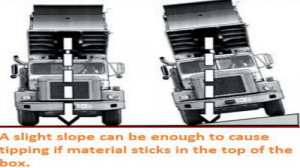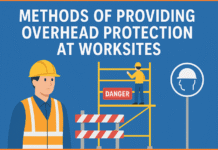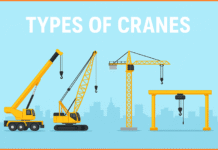Contents
DUMPER TRUCK SAFETY
Dump trucks are considered to be the workhorses of the construction industry due to their wide usage in material transportation. Over the many years, they have become so common that despite their usefulness, they have also become the source of serious injuries and fatalities.

Recently at one of our active Construction sites, one incident happened where a dump truck toppled while unloading material from its bed. As everyone working near maintained a safe distance, no injury resulted. Upon investigation, it was found that improper ground conditions and poor judgment of the operator led to the instability of the truck and resulted in toppling.
A Dumper truck is a truck used for transporting and carry loose material such as sand, gravel, or dirt. A typical dumper truck is equipped with an open-box bed, with a hinged rear gate and is equipped with hydraulic pistons to lift the front, allowing the material in the bed to be deposited (dumped) on the ground behind the truck at the delivery site.
One of the major hazards related to the use of dump/tipper trucks is tip-over.
This hazard majorly arises when the truck box is in the raised position and when the center of gravity of the box and load is not roughly between the frame rails of the unit.
One or more of the following factors can adversely affect stability:

- The truck is not on a level surface when dumping.
- A large amount of materials is in the upper position of the raised box.
- The rear wheels settle unevenly as the load moves to the rear while dumping.
- Poor rear suspension systems on one side of the dump truck.
- Uneven tire pressures in rear wheels.
- Worn or inadequate components of the lifting system such as pins, lifting cylinders.
SAFETY GUIDELINES TO BE FOLLOWED WHILE USING DUMP/TIPPER TRUCKS INCLUDE:
Pre-Use Activities
- Review and understand the information provided in the dump truck operator’s manual with particular attention given to descriptions of safety procedures.
- Inspect the dumper truck/dump truck, including the head and tail lights, horn, rearview mirrors, tires, air brakes, and fluid levels, and also maintained the manufacture daily checklist.
- Check tire pressures daily. Tire pressures should be equal on each side of the vehicle, according to manufacturers’ recommendations.
- If any dump truck equipment fails the pre-use inspection, the equipment has to be returned back to the owner to make necessary repairs.
CLICK HERE FOR HYDRA CRANE SAFETY
Operating Precautions
- During entering or exiting the cab of a dump truck, always use the handhold and steps.
- Know the locations of obstacles such as boulders, overhead electric lines, fences, and low tree limbs in areas where loading, hauling, and dumping will occur.
- Be aware of blind spots when reversing a dumper truck. Carefully adjust rearview mirrors to maximize you’re of view area. Always use a “spotter/signal person” when backing a dump truck.
- Know where other workmen are located in the loading, hauling, and dumping areas.
- Engage the dumper-box lock bars before performing maintenance or other jobs under a raised dumper box.
- Recognize surface areas hazardous to dumping’s, such as uneven and sloping surfaces or poorly compacted fill. Dumping loads during located on hazardous location, areas may result in vehicle tip-overs.
- Ensure the length of travel is reasonably level and compacted before spreading material by dumping from a moving truck.
- Dumper trucks should not dump any material when they are parked side by side with another vehicle. When a dump truck tips over, it is often the operator in the adjoining vehicle that is injured.
- Obey all traffic rules and speed limits that are applicable to project/site roads.
- Don’t work under a raised box (not even “for just a little bit”) unless the box is adequately supported by a prop rod or cribbing. Do not rely on the truck’s hydraulic system to hold the box up while working under it.
Be aware of the hazards and risks while using the Dump/Tipper Truck. Ensure adequate safety measures before and during job execution are fulfilled. Your constant vigilance, timely and prompt actions could eliminate major incidents.






This safety topic is very good, and will help all safety professionals,
I Like it and I shall implement it at my site.
Thank You
That’s a good work keep it please.
I like it.
You are posting deep and useful info ,people from safety field should use this as guidelines a nd criterion…..Thank you sir
I like how you included that if the dump truck is not on a level surface then it can affect stability. My husband is wanting to build a pool in our backyard and will need to use one to help him build it and he wanted to know some safety tips. I’ll make sure to pass this information along to him when he uses a dump truck.